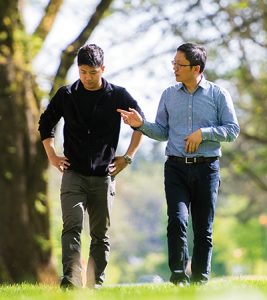 Cable-assisted harvesting systems are gaining popularity in the Pacific Northwest. Stewart Professor of Forest Operations Woodam Chung says there are about 20 systems in use in the Pacific Northwest already, and that number is growing.
Cable-assisted harvesting systems are gaining popularity in the Pacific Northwest. Stewart Professor of Forest Operations Woodam Chung says there are about 20 systems in use in the Pacific Northwest already, and that number is growing.
The systems are undeniably safer than traditional cable yarding systems and manual cutting, because, thanks to mechanized harvesting, cameras and other technology, no one has to be on the forest floor near falling trees.
“One worker sits at the top of a hill with a camera,” explains Graduate Student Preston Green. “He can see where his grapples are and grab the logs at a safe distance.”
Chung says this process eliminates the need for choker setters and fellers – some of the most dangerous jobs in the forest industry.
The technology for cable-assisted harvesting was developed in Europe about 20 years ago, and recently adapted by Oregon State for use on steep slopes in the Pacific Northwest.
Once the tree is cut by a cable-assisted cutting machine, the machine swings and piles the tree along the skyline corridor, where it will be picked up and transported to a mill for processing.
In addition to the safety of the system, Chung is looking at other aspects including soil impact. His research team has already completed two studies on soil impact. He says industry professionals and members of the public perceive large equipment causes soil compaction, but two initial studies, one in the McDonald-Dunn Forest and one on Lone Rock Timber’s land, concluded that, depending on soil types and moisture content, loosening may occur after machine traffic.
“Now the question is, what does this mean in terms of erosion or soil moisture content?” asks Chung. “That’s what we’re looking at now.”
Chung and his team will continue to study interactions between soil, machine and water.
“We will use silt fences to look at erosion and measure the amount of erosion we collect,” Chung says.
Researchers want to learn what kind of impact this erosion might cause on water quality in streams and rivers at the base of logging operations.
Another aspect of the study is the economic impact.
“Cable-assisted mechanized harvesting is more productive than manual cutting, especially on steep slopes,” Chung says, “But the machine is expensive. Timber companies will have to weigh the costs and benefits for themselves and decide how to harvest.”
Green agrees, “If these systems can produce more timber at a reduced cost, then it’s a win-win for everyone involved.”

